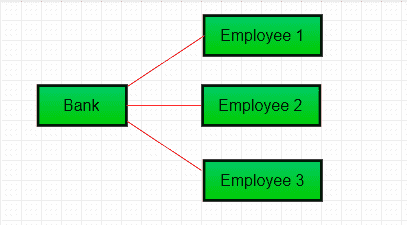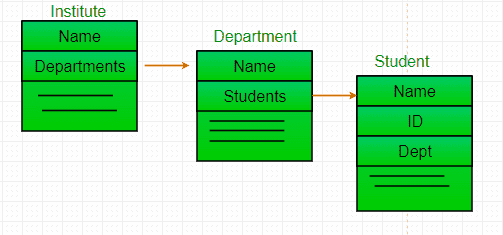关联是通过对象建立的两个独立类之间的关系。关联可以是一对一、一对多、多对一、多对多。在面向对象编程中,一个对象与另一个对象通信,以使用该对象提供的功能和服务。 作文 和 聚集 是两种形式的联系。

例子:
JAVA
// Java Program to illustrate the // Concept of Association // Importing required classes import java.io.*; // Class 1 // Bank class class Bank { // Attribures of bank private String name; // Constructor of this class Bank(String name) { // this keyword refers to current instance itself this .name = name; } // Method of Bank class public String getBankName() { // Returning name of bank return this .name; } } // Class 2 // Employee class class Employee { // Attribures of employee private String name; // Employee name Employee(String name) { // This keyword refwrs to current insytance itself this .name = name; } // Method of Employee class public String getEmployeeName() { // returning the name of employee return this .name; } } // Class 3 // Association between both the // classes in main method class GFG { // Main driver mmethod public static void main(String[] args) { // Creating objects of bank and Employee class Bank bank = new Bank( "ICICI" ); Employee emp = new Employee( "Ridhi" ); // Print and display name and // corresponding bank of employee System.out.println(emp.getEmployeeName() + " is employee of " + bank.getBankName()); } } |
Ridhi is employee of ICICI
输出说明: 在上面的示例中,两个独立的类Bank和Employee通过其对象关联。银行可以有很多员工,所以是一对多的关系。

聚集
这是一种特殊的结社形式,其中:
- 它代表了Has-A的关系。
- 这是一个 单向联想 i、 e.单向关系。例如,一个系可以有学生,但反之亦然是不可能的,因此是单向的。
- 总之, 两个条目都可以单独保存 这意味着终止一个实体不会影响另一个实体。
![图片[3]-Java中的关联、组合和聚合-yiteyi-C++库](https://www.yiteyi.com/wp-content/uploads/geeks/20190930/geeks_Aggregation.jpeg)
聚集
实例
JAVA
// Java program to illustrate Concept of Aggregation // Importing required classes import java.io.*; import java.util.*; // Class 1 // Student class class Student { // Attributes of student String name; int id; String dept; // Constructor of student class Student(String name, int id, String dept) { // This keyword refers to current instance itself this .name = name; this .id = id; this .dept = dept; } } // Class 2 // Department class contains list of student objects // It is associated with student class through its Objects class Department { // Attributes of Department class String name; private List<Student> students; Department(String name, List<Student> students) { // this keyword refers to current instance itself this .name = name; this .students = students; } // Method of Department class public List<Student> getStudents() { // Returning list of user defined type // Student type return students; } } // Class 3 // Institute class contains list of Department // Objects. It is associated with Department // class through its Objects class Institute { // Attributes of Institute String instituteName; private List<Department> departments; // Constructor of institute class Institute(String instituteName,List<Department> departments) { // This keyword refers to current instance itself this .instituteName = instituteName; this .departments = departments; } // Method of Institute class // Counting total students of all departments // in a given institute public int getTotalStudentsInInstitute() { int noOfStudents = 0 ; List<Student> students; for (Department dept : departments) { students = dept.getStudents(); for (Student s : students) { noOfStudents++; } } return noOfStudents; } } // Class 4 // main class class GFG { // main driver method public static void main(String[] args) { // Creating object of Student class inside main() Student s1 = new Student( "Mia" , 1 , "CSE" ); Student s2 = new Student( "Priya" , 2 , "CSE" ); Student s3 = new Student( "John" , 1 , "EE" ); Student s4 = new Student( "Rahul" , 2 , "EE" ); // Creating a List of CSE Students List<Student> cse_students = new ArrayList<Student>(); // Adding CSE students cse_students.add(s1); cse_students.add(s2); // Creating a List of EE Students List<Student> ee_students = new ArrayList<Student>(); // Adding EE students ee_students.add(s3); ee_students.add(s4); // Creating objects of EE and CSE class inside // main() Department CSE = new Department( "CSE" , cse_students); Department EE = new Department( "EE" , ee_students); List<Department> departments = new ArrayList<Department>(); departments.add(CSE); departments.add(EE); // Lastly creating an instance of Institute Institute institute = new Institute( "BITS" , departments); // Display message for better readability System.out.print( "Total students in institute: " ); // Calling method to get total number of students // in institute and printing on console System.out.print(institute.getTotalStudentsInInstitute()); } } |
Total students in institute: 4
输出说明: 在这个例子中,有一个研究所没有像CSE,EE这样的部门。每个系都有学生。因此,我们制作了一个Institute类,该类引用了Department类的Object或Object数量(即Object列表)。这意味着Institute类通过其对象与Department类相关联。Department类还引用了学生类的一个或多个对象(即对象列表),这意味着它通过其对象与学生类相关联。
它代表着一种 有一个 关系在上面的例子中:学生 有一个 名称大学生 有一个 学生证 有一个 部门 有一个 学生如以下媒体所示。

我们什么时候使用聚合?? 代码重用最好通过聚合实现。
概念3: 作文
![图片[5]-Java中的关联、组合和聚合-yiteyi-C++库](https://www.yiteyi.com/wp-content/uploads/geeks/20190930/geeks_Aggregation-1.jpeg)
作文
组合是一种受限的聚合形式,其中两个实体彼此高度依赖。
- 它代表 部分 关系
- 在组合中,两个实体相互依赖。
- 当两个实体之间存在合成时,合成的对象 不可能存在 没有其他实体。
实例 图书馆
JAVA
// Java program to illustrate // the concept of Composition // Importing required classes import java.io.*; import java.util.*; // Class 1 // Book class Book { // Attributes of book public String title; public String author; // Constructor of Book class Book(String title, String author) { // This keyword refers to current instance itself this .title = title; this .author = author; } } // Class 2 class Library { // Reference to refer to list of books private final List<Book> books; // Library class contains list of books Library(List<Book> books) { // Referring to same book as // this keyword refers to same instance itself this .books = books; } // Method // To get total number of books in library public List<Book> getTotalBooksInLibrary() { return books; } } // Class 3 // Main class class GFG { // Main driver method public static void main(String[] args) { // Creating objects of Book class inside main() // method Custom inputs Book b1 = new Book( "EffectiveJ Java" , "Joshua Bloch" ); Book b2 = new Book( "Thinking in Java" , "Bruce Eckel" ); Book b3 = new Book( "Java: The Complete Reference" , "Herbert Schildt" ); // Creating the list which contains number of books List<Book> books = new ArrayList<Book>(); // Adding books // using add() method books.add(b1); books.add(b2); books.add(b3); Library library = new Library(books); // Calling method to get total books in library // and storing it in list of user0defined type - // Books List<Book> bks = library.getTotalBooksInLibrary(); // Iterating over books using for each loop for (Book bk : bks) { // Printing the title and author name of book on // console System.out.println( "Title : " + bk.title + " and " + " Author : " + bk.author); } } } |
Title : EffectiveJ Java and Author : Joshua BlochTitle : Thinking in Java and Author : Bruce EckelTitle : Java: The Complete Reference and Author : Herbert Schildt
输出说明: 在上面的例子中,一个库可以有 书 关于相同或不同的主题。所以,如果图书馆被毁,那么该图书馆内的所有书籍都将被毁。i、 电子书离不开图书馆。这就是为什么它是构图。书是 部分 图书馆
聚合与合成
1.依赖性: 聚合意味着一种关系,其中 可以独立存在 父母的。例如,银行和员工,删除银行和员工仍然存在。而构图意味着孩子 不能独立存在 父母的。例:人与心,心不是独立于人而存在的
2.关系类型: 聚合关系是 “有一个” 构图是 “部分” 关系
3.协会类型: 作文是一门艺术 坚强的 关联,而聚合是一种 虚弱的 协会
例子:
JAVA
// Java Program to Illustrate Difference between // Aggregation and Composition // Importing I/O classes import java.io.*; // Class 1 // Engine class which will // be used by car. so 'Car' // class will have a field // of Engine type. class Engine { // Method to starting an engine public void work() { // Print statement whenever this method is called System.out.println( "Engine of car has been started " ); } } // Class 2 // Engine class final class Car { // For a car to move, // it needs to have an engine. // Composition private final Engine engine; // Note: Uncommented part refers to Aggregation // private Engine engine; // Constructor of this class Car(Engine engine) { // This keywords refers to same instance this .engine = engine; } // Method // Car start moving by starting engine public void move() { // if(engine != null) { // Calling method for working of engine engine.work(); // Print statement System.out.println( "Car is moving " ); } } } // Class 3 // Main class class GFG { // Main driver method public static void main(String[] args) { // Making an engine by creating // an instance of Engine class. Engine engine = new Engine(); // Making a car with engine so we are // passing a engine instance as an argument // while creating instance of Car Car car = new Car(engine); // Making car to move by calling // move() method inside main() car.move(); } } |
Engine of car has been started Car is moving
在聚合的情况下,汽车还通过发动机执行其功能。但发动机并不总是汽车的内部部件。发动机可以更换,甚至可以从车上拆下。这就是为什么我们将“引擎类型”字段设为非最终字段。
本文由 尼茨海伦德拉 .如果你喜欢GeekSforgek,并想贡献自己的力量,你也可以使用 写极客。组织 或者把你的文章寄去评论-team@geeksforgeeks.org.看到你的文章出现在Geeksforgeks主页上,并帮助其他极客。如果您发现任何不正确的地方,或者您想分享有关上述主题的更多信息,请写下评论。


![关于”PostgreSQL错误:关系[表]不存在“问题的原因和解决方案-yiteyi-C++库](https://www.yiteyi.com/wp-content/themes/zibll/img/thumbnail.svg)






